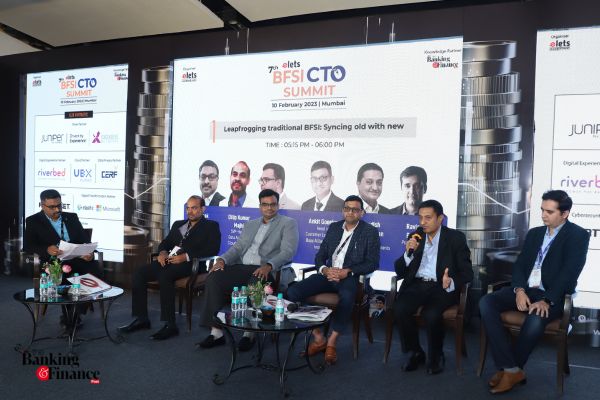Digital technologies are rapidly transforming the banking industry by enabling faster, more efficient, and more secure financial services. The adoption of these technologies is changing the way banks operate, interact with customers, and compete with each other. Keeping the same in mind, a panel discussion on Leapfrogging traditional BFSI: Syncing old with new was held at 7th Elets BFSI CTO Summit on February 10th in Mumbai.
Deepak Damodar V, Assitant General Manager, South Indian Bank
Digital disruption has been a topic of discussion since the beginning of this era, with examples such as the transformation of banks into core banking systems, the implementation of payment systems like UPI, and the rise of work from home during the COVID-19 pandemic. These changes are driven by new technologies and business models that are disrupting existing industries and markets, creating new opportunities and challenges. To succeed in this new digital world, companies need to be agile, adaptable, and mindful of the ethical and regulatory implications of their actions.
Dilip Kumar Majhi, SVP-Head-Data Analytics Cloud Platform, Axis Bank
Digital disruption has been a major force in shaping our world since the introduction of computers in 1982 and the widespread adoption of the internet in 2006. This shift has brought about significant changes in various industries, including lean management practices. In the banking sector, digital disruption has led to the development of digital lending platforms, allowing customers to open accounts and apply for loans from the comfort of their homes.
He said, “During the COVID-19 pandemic, there has been an even greater push towards digital transformation, with many companies investing in new technologies and platforms to serve their customers better. One such example is the digital payroll system, which allows employees to access their salaries and other financial information online.”
Additionally, he said, “However, the term “digital” is constantly evolving, and what may have been considered a digital transformation just a few years ago may now be outdated. As technology continues to advance, companies need to be agile and adaptable, constantly looking for new ways to improve their processes and stay ahead of the curve.”
Despite the benefits of digital disruption, there are also challenges that need to be addressed. One of the most significant concerns is around data privacy and security, with many companies facing data breaches and other cyber threats. As a result, it’s essential for organisations to take a proactive approach to cybersecurity and invest in the necessary tools and resources to keep their systems safe.
Concluding the session, he stated, “Digital disruption has been a game-changer in many industries, transforming the way we live, work, and interact with each other. While there are certainly challenges to be addressed, the benefits of digital transformation are clear, and companies that embrace this change are well-positioned to succeed in the digital age. By staying agile, adaptable, and mindful of emerging technologies and trends, businesses can continue to innovate and thrive in this ever-changing digital landscape.”
Tejasvi Addagada, SVP, Chief Data Office, HDFC Bank
In today’s world, data is the new oil, and organisations across industries are leveraging it to enhance their operations, drive innovation and create new revenue streams. However, with the increasing amount of data being generated, the focus has shifted from hoarding data to curating it and using it for specific purposes. This shift is essential not just from a regulatory perspective but also to derive maximum value from the data.
“The shift towards data curation is a result of various factors such as compliance regulations like GDPR, CCPA, and upcoming DPB in India, which mandate the need to collect only necessary data, store it securely, and delete it once its purpose is served. Organisations now have to focus on building robust data management systems that can protect sensitive data and enable authorized access’, he averred.
But data curation is not just about compliance. It’s also about humanizing the digital experience. The focus is on using data to create personalized experiences that cater to individual customer needs. With the advancements in technology, data is now being used to enhance customer experiences across all channels – be it mobile, email, WhatsApp, or chatbots like ChatGPT.
He stated, “Banks are now focusing on digitising customer onboarding to make the process seamless and efficient. This includes using technologies like QR codes in branches to allow customers to scan and request to change their address, update their contact information or open a new account. By leveraging data, banks can reduce the onboarding time, minimise errors, and provide a frictionless experience for their customers.”
Also Read | Innovation or Survival: Financial strategies for growth in 2023
“Data curation is the paradigm shift in the way organisations manage their data. It’s about curating what is necessary, protecting it, and using it to enhance customer experiences and create new revenue streams. With the advancements in technology, data is becoming the new currency, and organisations that can leverage it effectively will have a significant competitive advantage”, he concluded.
Ankit Goenka, Head of Customer experience, Bajaj Allianz General Insurance
Blockchain and other emerging technologies are transforming the insurance industry. However, with all these digital advancements, there is a growing concern about how the old is going to meet the new. This brings us to the topic of how the movement of truth claims, and how it has evolved from the traditional paper-based method to a more modern and efficient digital approach.
He commenced the session by saying, “In the past, when someone had a motor accident, a physical surveyor would be appointed to assess the damage. This would be followed by a lengthy paperwork process, which could take up to 30 days before the claim was settled. However, with the advent of digital technology, the entire process has been streamlined, and it now takes only a few minutes to settle a claim.”
This has been made possible by leveraging old data, which has been migrated to the cloud and enhanced with AI and photogrammetry. The result is a product called motor on the spot, which allows customers to upload pictures of their damaged vehicle using a mobile app. The AI system then assesses the damage and calculates the cost, which is transferred directly to the customer’s account.
“This is just one example of how digital transformation is revolutionising the insurance industry. However, the challenge now is to humanize the digital process. While digital technology has made insurance processes more efficient, it has also led to a loss of the human touch”, he stated.
For instance, customers who make a claim often feel that they are dealing with a faceless organisation, rather than a company that cares about their needs. This is where the concept of humanising the digital process comes in. By combining technology with empathy, insurance companies can create a more personalised experience for their customers.
One way to achieve this is by using chatbots that can interact with customers in a more natural and conversational manner. By using machine learning algorithms, these chatbots can learn from past conversations and tailor their responses to individual customers’ needs.
He added, “Another way to humanise the digital process is by providing customers with access to a human representative when they need it. This can be achieved by providing a dedicated hotline that customers can call when they have a query or need assistance.”
Concluding the session, he averred, “The insurance industry is in the midst of a digital transformation that is changing the way claims are settled. However, as we move forward, it is essential to remember that customers want more than just efficiency. They also want a human touch that makes them feel valued and cared for. By humanising the digital process, insurance companies can create a more personalised experience for their customers, which will ultimately lead to greater customer satisfaction and loyalty.”
Jagdish Narayanan, Chief Information Officer, Reliance Jio Payments Bank
Collaboration is the key to achieving inclusive growth in the financial sector. It is very clear that no single entity can achieve this goal single-handedly, no matter how large or wide its reach may be. To create a truly inclusive ecosystem, all players, including customers and regulators, must come together to work towards a common goal.
“One excellent example of collaboration in the financial sector is the Unified Payment Interface (UPI). UPI has democratised payments by allowing customers to transfer money from their bank accounts to other accounts seamlessly, without having to log in to the bank’s app or website. This has completely transformed the way people transact money in India”, stated Jagdish.
In the UPI ecosystem, payment service providers (PSPs) have been able to provide a superior front-end experience to customers, while the back-end remains with the banks. Money can now move from one bank to another with ease, thanks to the collaboration between banks and fintech companies.
He gave another example of collaboration in the financial sector which is the Account Aggregator framework. This framework allows for the movement of data from one financial information provider (FIP) to another financial information user (FIU) through a third-party entity known as the account aggregator. This way, the front-end experience need not be tied down to individual entities like banks or NBFCs.
It is evident that the future of the financial sector lies in collaboration. No one person or entity can attempt to do everything by themselves, and it is not the core expertise of any individual to do so. By coming together and leveraging each other’s strengths, financial entities can create a truly inclusive ecosystem that benefits everyone.
In conclusion, he expressed, “The success of initiatives like UPI and the Account Aggregator framework demonstrates that when everyone works together towards a common goal, we can achieve great things. By continuing to collaborate and innovate, the financial sector can continue to push boundaries and create a more inclusive world for all.”
Ravindra Ramnani, Principal Solution Architec, Elastic
The launch of the Unified Payments Interface (UPI) in 2016-2017 marked a turning point for digital payments in India. The UPI allowed for instant and secure transactions between bank accounts, making it a game-changer in the world of digital payments. Since then, the UPI has witnessed exponential growth, with billions of transactions happening every month.
The increase in the number of transactions has led to a massive amount of data being generated, not just for the UPI but for other payment systems like the Bharat Bill Payment System (BBPS) as well. The amount of data being generated has become humongous, and it has become essential to manage it effectively.
While giving the right solution to end customers is crucial, it is equally important to ensure that employees have access to the right data at the right time. Organisations should strive to give their employees the best experience, not just their customers. Enabling employees to access data and make informed decisions can enhance the customer experience and contribute to business growth.
“To provide the best customer experience, organisations need to focus not only on their digital channels but also on their customer experience teams. The quality of customer service provided by the team can significantly impact customer satisfaction and loyalty. Providing the best experience to employees is also essential. Employees who are satisfied with their work environment and have access to the right data can contribute significantly to business growth”, shared Ravindra.
The launch of the UPI marked a significant turning point in the world of digital payments in India. The exponential growth in the number of transactions has led to a massive amount of data being generated. Organisations must manage this data effectively and provide employees with access to the right data to make informed decisions. Providing the best customer experience, not just from digital channels but also through customer experience teams, is crucial. Additionally, enabling employees to access data and make informed decisions can contribute to business growth. Ultimately, organisations that focus on providing the best experience to both customers and employees are poised for success in the long run, he concluded.
Elets The Banking and Finance Post Magazine has carved out a niche for itself in the crowded market with exclusive & unique content. Get in-depth insights on trend-setting innovations & transformation in the BFSI sector. Best offers for Print + Digital issues! Subscribe here➔ www.eletsonline.com/subscription/



















